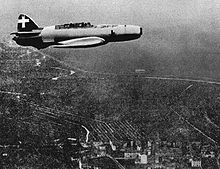Campini-Caproni CC2
| CC2 | |
|---|---|

|
|
| Type: | Jet-powered experimental aircraft |
| Design country: | |
| Manufacturer: |
Caproni |
| First flight: |
August 27, 1940 |
| Number of pieces: |
3 |
The Campini-Caproni CC2 (often referred to as "Campini-Caproni N.1") is an air-aspirating, thermojet-powered aircraft that was built in Italy . The first flight was on August 27, 1940. The CC2 was the second jet-powered aircraft in the world.
history
prehistory
Although Italy was not one of the leading countries in the field of air jet propulsion , the Caproni Campini CC.2 was the second country in which such an aircraft flew. In truth, however, this was nothing more than a brilliant idea using a conventional piston engine to drive a ducted propeller as a compressor with adjustable blades and imperfect post-combustion. As such, this drive made no contribution to gas turbine research , but led to a dead end. The engineer Secondo Campini founded a company in 1931 to conduct research in the field of jet propulsion.
Emergence
Ing. Secondo Campini convinced in 1939 Gianni Caproni to build an airplane in order to test the fruits of his labor, namely the adaptation of the V - twelve-cylinder - aircraft engine Isotta Fraschini Asso L.121 RC.40 with 671 kW (912 hp) to the drive of a three-stage axial jacket compressor, whereby the compressed air was expelled through a nozzle with variable cross-section in the rearmost part of the aircraft tail and additional fuel could be ignited in the jet pipe to increase the thrust. This made the CC2 the first jet-propelled aircraft to have a nozzle with a variable cross-section.
First flight
This two-seat machine CC2 with the serial number MM487 was flown for the first time on August 27, 1940 in Taliedo by Mario de Bernardi for a little over 10 minutes. On September 16 of the same year, the first prototype was flown again for 5 minutes.
Further testing
A number of carefully planned demonstration flights were carried out, including one over 270 km from Taliedo to Guidonia Montecelio near Rome at an average speed of 209 km / h. The second prototype (MM488) flew on April 30, 1941, its first official flight took place on November 30, 1941, when Mario De Bernardi and the engineer Giovanni Pedace flew in the rear cockpit from Milano-Linate airport to Guidonia, 475 km covered at an average speed of 217 km / h. A third copy was completed without an engine.
Reactions
The Caproni and Campini venture turned out to be a terrific success for the Italian fascist regime, which massively promoted aviation regardless of cost. Italy received a total of 33 congratulatory telegrams from abroad and the International Aviation Association ( FAI) homologated the CC2 as the first jet-powered aircraft in the world - because until then the aviation world had no knowledge of the secret attempts by Hans von Ohain and Heinkel about a year earlier in German Reich when they let the Heinkel He 178 fly for the first time on August 27, 1939 .
Termination of the experiment
From the beginning it was clear that the use of a three-stage jacket compressor, which was driven by a piston engine, would restrict further development. The experiment was therefore abandoned at the beginning of 1942, but mainly because of the unexpectedly low top speed.
Whereabouts
The first prototype was probably destroyed in 1943. The remains were brought to the Royal Aircraft Establishment in Farnborough in England in October 1944 and scrapped after several stopovers in 1949. The second prototype was preserved and is now exhibited in the Italian Aviation Museum Vigna di Valle near Rome . The third airframe is now owned by the Leonardo da Vinci Science and Technology Museum in Milan .
Technical specifications
| Parameters | Data |
|---|---|
| length | 13.10 m |
| span | 15.85 m |
| Wing area | 36.00 m² |
| Takeoff mass | 4195 kg |
| Engine | a V12 engine Isotta Fraschini Asso L.121 RC.40 with 671 kW (912 PS) to drive a three-stage axial compressor |
| thrust | 6.9 kN (approx. 700 kg) |
| Top speed | 375 km / h at 3000 m altitude with afterburner 359 km / h at 3000 m altitude without afterburner |
| Service ceiling | 12,000 m |
| Range | 940 km |
Comparable types
Motor air jet engine
Turbine air jet engine
- Heinkel He 178 - the world's first jet aircraft from Germany
- Gloster E.28 / 39 - first British jet aircraft
- P-59 Airacomet - first American jet aircraft
See also
Web links
Individual evidence
- ↑ a b Q&A, Airplane Monthly, June 2010, p. 60
- ^ Aeronautica Militare: Museo Storico di Vigna di Valle. In: Campini-Caproni 2. Ministero della Difesa, accessed on October 11, 2018 (Italian).


